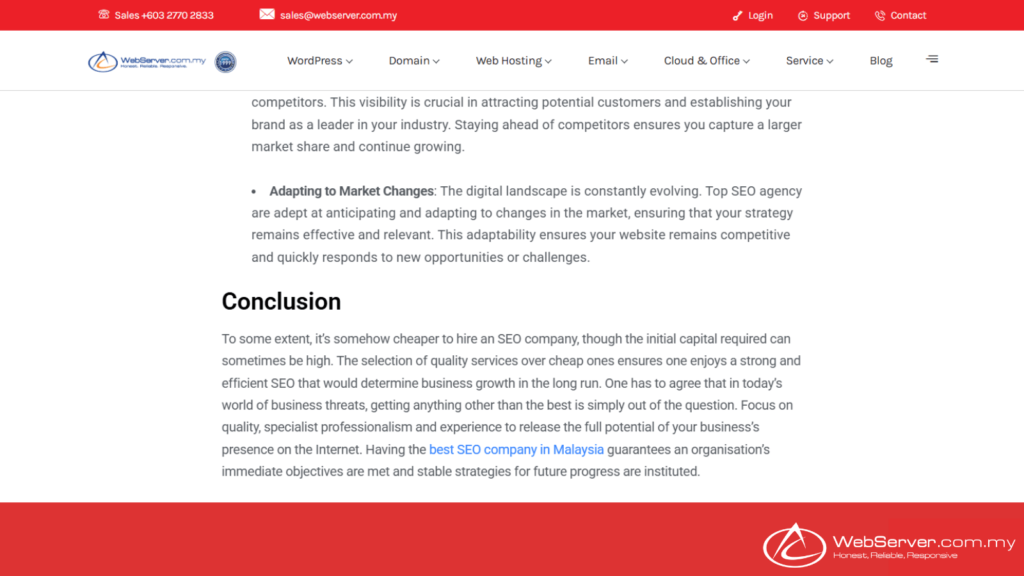-
Sales +603 2770 2833
- sales@webserver.com.my
What is SEO writing and how do I do it
Table of Contents
Toggle
SEO content writing plays a vital role in digital marketing, focusing on the creation of SEO-optimised content that addresses relevant search queries. The SEO writing process involves crafting engaging blog posts that not only inform but also rank well on search engines. Understanding the importance of SEO writing is crucial for driving traffic and increasing visibility. In today’s constantly changing digital world, content creation involves more than just putting words on a page; it’s about crafting content that captivates readers and ranks high in search engine results. This is where SEO writing comes in. SEO (Search Engine Optimisation) writing is the process of creating content that not only appeals to the search engines but also resonates with your audience. But how exactly do you achieve this? Let’s dive into what SEO writing entails and how you can master it.
Why is SEO writing important?
SEO writing involves creating content tailored to rank well on search engines. The main objective is to boost your content’s visibility on search engines such as Google, ultimately leading to increased organic traffic to your website. However, SEO writing is not merely about inserting keywords into your content. It’s about comprehending what your audience seeks and providing high-quality content that meets their needs while following SEO best practices.
Search engines use sophisticated algorithms to rank content. These algorithms consider several factors, such as keyword relevance, content quality, user engagement, and website authority. SEO writing is focused on optimising your content based on these factors to improve your website’s ranking in search results.
Key Elements of Writing With SEO In Mind
To master writing with SEO in mind, you need to understand and implement several key elements. These components work together to create search engine-friendly content that is valuable to your readers.
Keyword Research

Keywords serve as the basis for SEO writing. People use the terms and phrases when searching for information on search engines. Good keyword research involves finding relevant keywords for your content while balancing search volume and competition.
- Importance: Keywords are important for helping search engines understand the topic of your content. Targeting the right keywords ensures that your content reaches the appropriate audience. For instance, if you are writing about ‘healthy eating tips,’ it’s essential to research related keywords such as ‘nutrition tips,’ ‘healthy diet,’ and ‘balanced meals.’
- Tools for Keyword Research: Utilise tools like Google Keyword Planner, Ahrefs, SEMrush, or Ubersuggest to discover keywords aligned with your content’s topic. These tools offer insights into the search volume and competition and suggest relevant keywords you may have yet to consider.
- Long-Tail Keywords: Don’t overlook long-tail keywords. They consist of more specific and usually longer phrases. Though these keywords have lower search volumes, they often lead to better conversion rates because they reflect more specific search intent. For instance, “best healthy diet plans for weight loss” is a long-tail keyword targeting users seeking information.
Content Creation
Once you’ve identified your target keywords, you can create content that includes them and provides real value to your readers.
- Quality Content: Search engines prioritise informative, engaging, and valuable content. Your content should answer the questions that your audience is asking. Focus on creating comprehensive, in-depth content that covers a topic thoroughly. For instance, if you’re writing about “home workouts,” don’t just list exercises—explain the benefits, provide tips, and include variations for different fitness levels.
- User Intent: It’s important to understand user intent. Determine whether people seek general information, a how-to guide, or a product review. Customise your content to align with the purpose behind the search query. For instance, if someone searches “how to start a blog,” they probably want a step-by-step guide rather than just a definition.
- Content Structure: Please structure your content to make it easy to read and navigate. Use clear headings and subheadings to break up the text. Include bullet points or numbered lists when necessary. This improves readability and helps search engines understand the hierarchy and importance of the content.
- Visual Content: Remember not to consider the impact of visual content. Using images, infographics, and videos can improve the quality of your content and make it more captivating. Ensure all visual content is optimised for SEO by giving descriptive file names and adding alt text with relevant keywords.
On-Page SEO
On-page SEO refers to optimising individual web pages to rank higher and earn more relevant traffic. It involves both the content itself and the HTML source code.
- Title Tags and Meta Descriptions: The title tag is among the most important on-page SEO elements. It should include your primary keyword and clearly describe the page’s content. Although not a direct ranking factor, the meta description significantly encourages users to click on your link in the search results. A well-crafted meta description can improve your click-through rate (CTR).
- Keyword Placement: Ensure that you strategically place keywords within your content. Your main keyword should be in the title, the first 100 words, repeated several times throughout the content. However, avoid keyword stuffing, as it can result in penalties from search engines. Instead, incorporate variations and synonyms of your primary keyword to maintain natural and engaging content.
- Header Tags (H1, H2, H3, etc.): Use header tags to organise your content. The H1 tag is meant for the main title, while the H2 and H3 tags can be used for subheadings. This structure assists search engines in comprehending the organisation of your content and determining its significance.
- Image Optimisation: Images are crucial for enhancing user experience and must be optimised for SEO. This can be achieved by using relevant file names, compressing images to reduce loading time, and including alt text with appropriate keywords to describe the image content.
Internal Links and External Linking

Links are essential in SEO, as they connect your content to other relevant resources.
- Internal Links: Internal linking is the practice of linking to other pages on your website. This helps search engines discover new content on your site and understand the relationship between different pages. It also encourages users to explore more of your content, which can increase their time on your site.
- External Links: External linking, or outbound linking, involves linking to reputable, authoritative websites. This adds credibility to your content and signals to search engines that your content is well-researched. When linking externally, choose high-authority sites relevant to your content’s topic.
- Anchor Text: The anchor text in a hyperlink should be descriptive and relevant to the linked content. Avoid generic phrases like “click here” and use keywords or phrases that describe the related content.
By strategically adding internal links within these blog posts, writers can enhance user experience and improve site navigation, further supporting search engine optimisation efforts.
User Experience (UX)
User experience is a critical factor in SEO. Search engines like Google prioritise content that provides a positive user experience.
- Readability: To ensure your content is easy to read, remember to use short paragraphs, simple language, and plenty of easier reading. Break up long blocks of text with subheadings, bullet points, and images. Doing so will improve readability, keep readers engaged, and reduce your bounce rate.
- Mobile Optimisation: Optimising your mobile content is essential, as most web traffic comes from mobile devices. Use responsive design to ensure that your content displays correctly on all devices and that buttons and links are easy to tap on smaller screens.
- Page Speed: Page loading speed is a ranking factor for desktop and mobile searches. Slow-loading pages can frustrate users and result in higher bounce rates. To improve your page speed, optimise images, leverage browser caching, and minimise the use of heavy scripts.
Best Practices for SEO Writing
To consistently produce high-ranking content, it’s essential to follow best practices and stay current with the latest SEO trends.
- Consistency is Key: Search engines favour websites regularly updated with fresh content. Consistently publishing new content and updating older posts can signal to search engines that your site is active and relevant. Aim to create a content calendar to keep your publishing schedule on track.
- Leverage Analytics: Use tools like Google Analytics to monitor your content’s performance. Pay attention to metrics such as organic traffic, bounce rate, average session duration, and conversion rates. Analysing this data can help you identify which content performs well and where there’s room for improvement.
- Voice Search Optimisation: With the increasing popularity of voice-activated devices like Google Home and Amazon Alexa, optimising your content for voice search is becoming more important. Focus on natural language and long-tail keywords that mimic the way people speak. For example, instead of “best SEO tips,” you might target “What are the best tips for SEO success?”
- Content Refreshing: Don’t forget to revisit and refresh old content. Updating older articles with new information, optimising them for current SEO standards, and re-publishing them can give them a new lease on life and improve their rankings.
- Engagement and Social Sharing: Encourage readers to engage with your content by including calls to action (CTAs) that invite comments, shares, and likes. Social signals, like shares and likes on platforms like Facebook and Twitter, can indirectly influence your search rankings by driving traffic to your site.
Conclusion
SEO writing combines creativity with technical knowledge. It involves creating content that connects with your audience and is optimised for search engines. By mastering keyword research, focusing on high-quality content, using on-page SEO techniques, and improving user experience, you can produce content that ranks well and delivers genuine value to your readers.
It’s important to remember that SEO is not something you do once and forget about. It’s an ongoing process. The digital world is always changing, so staying up to date with the latest trends and best practices is essential to maintain and improve your search engine rankings. By implementing these SEO writing techniques today, you can expect your content to rise in search engine rankings, leading to increased visibility and traffic to your website.

WebServer.com.my, a business unit of a privately owned Acme Commerce Sdn Bhd was established in 1989. Specializes in the complex managed hosting services such as database hosting and mission critical application hosting since 1999.
-
Office Hour
+603 2770 2833 -
Extended
+603 2770 2803 -
Email
sales@webserver.com.my -
Technical Support
support@webserver.com.my
Switch The Language




